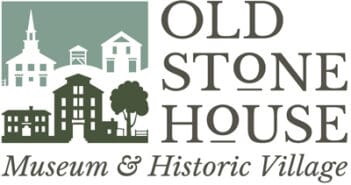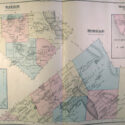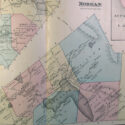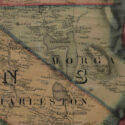Local History:
From the Vermont Historical Gazetteer, edited by Abby Maria Hemenway. Orleans County – Morgan Chapter: By Rev. Jacob S. Clark. Published by Claremont Manufacturing Co, 1877. Pgs 283-293.
The town of Morgan is situated in the N. E. part of Orleans County, lat 44° 50′ N. long. 6° 6′ E. The form of the township is irregular, bounded on the N. by Holland & Derby E. &N. E. by Warner’s Grant & Warren Gore, & E. by Brighton and S. W. by Charleston & Salem. It consists principally of what was originally chartered by the name of Caldersburgh. The charter is dated Nov 6, 1780. It was chartered by the State of Vermont, Thomas Chittenden Governor, to 64 grantees with five public rights viz. one for first settled minister, one for the support of the Gospel, one for college, one for county grammar school, and one for common school, each right containing 314 acres.
After the town was allotted (157 acres in each lot) an alteration was made in town lines and the south easterly portion was annexed to the township nlock (sic), -and to the north westerly on the N. W. Brownington Gore-and on the N. E. Whitelaw’s Gore-and the name of the town changed from Caldesburgh to Morgan. That part of the town formerly Caldesburgh contained about 15000 acres, Brownington 3,600, Whitelaw’s Gore 2,000, making the entire area of the town 20,000 acres, including water.
Brownington Gore was granted by the State of Vermont to the proprietors of Brownington and was allotted (40 acres in each lot, ) in July A. D. 1807 by Hon. Samuel Hinman. Some parts of the town are comparatively level, or gently sloping-other parts are broken with a pleasant variety of hills and valleys. There are no elevations of land which are here called mountains, though some might properly bear that name. Eton hill and Bear bill are the most considerable elevations. Eton hill is so called on account of a settlement being commenced on it by Eton Wilcox, and Bear hill receives its name from the circumstance of a bear having been seen upon it, before the town was settled, by a passing stranger.
From the summit of the former, we have a fine prospect. In a clear day, may be seen Lakes Memphremagog and Willoughby with a great many smaller collections of water and several villages in the neighboring towns. In the back-ground the more distant peaks of the Green Mountains meet the eye. There is also a chain of hills running through the town which (to the knowledge of the writer) has never received name
Seymour Lake is the principal collection of water. It lies in the form of a clumsy boot and covers an area of more than 16000 acres. Somewhere in this lake is said to be the geographical center of the town. It is one of the most beautiful sheets of water in the State, and the scenery around it is grand and picturesque. It abounds with several kinds of fish, which rendered of no small account to the early settlers. Lunge, cusk and white fish are the principal. Very large ones of the first mentioned have been caught. The largest is said to have weighed 39 1/2 lbs. Others at different times have been taken, weighing all along from 20 to 30 lbs. The smaller kinds weighing from 1 1/2 to 12 pounds are generally esteemed the most palatable. It is a fact worthy of notice that though there have been many hair-breadth escapes those who have been fishing and sailing on this lake, no one has ever yet been drowned in it.
Being fed by numerous living springs its water remarkably cold and pure. As another peculiarity – it takes much cold weather to freeze it over. For weeks after lake Memphremagog and all the other bodies of water in this vicinity have been bound in icy fetters. Lake Seymour may be seen steaming and lashing its shore as if in defiance of the frigid blasts. There are three other inconsiderable ponds in town, two of which are named, one Meed, and the other Toad-pond. The last mentioned is the source of a small stream, known by the name of Sucker-brook. It receives its name from the multitude of suckers taken from it. From one of the other lying in the north part of the town, and partly in Holland, flows the Mill-brook that empties into the head of the lake. Ferren’s River passes through a part of the town bordering on Brighton, in the valley of which passes the Atlantic and St Lawrence Rail Road. Almost every part of the town is well watered by living springs and small rivulets.
The principle growth of hard wood timber is sugar-maple, yellow birch, beech, elm, and brown and yellow ash, -that of soft wood is hemlock, spruce, fir, tamarack and cedar. The rocks are mostly granite, slate and milk quarts. Some beautiful specimens of crystal quartz have been found. There is a quarry of joint granite of the very nicest quality on the east side of the lake. Much of it has been transported to other towns for monuments and other choice purposes. The soil in general, for an upland town, is easily wrought and very productive. In the eastern section some of the farms are well supplied with granite boulders.
In regard to natural curiosities, there have been few discovered worthy of notice. Near the south-eastern shore of the lake there is a rock familiarly known by the name of the oven rock. It takes its name from a cavity on the side towards the shore very much resembling a brick oven. On the farm, also, of Dea. Win. Little, the writer has been informed of late, that there is a rock judged to weigh some 20 tons, lying with the rounding side upon another rock, so completely balanced that a very little strength applied to it will tip it either way, and when the force is removed it will adjust itself.
Among the hills in the eastern part of the town, (as reported by hunters and others, who have traversed the forest for different purposes) there are several caverns, fit habitations for wild beasts; but none of them have ever been explored. Before the forest was broken by the “sturdy blows” of the first settler, there was a piece of land now attached to the farm of Mrs. Wiggins which had every appearance of having been cleared at some former period. This little plot, from the first settlement of the town, has been called the Indian garden. It is also reported by some aged persons, that more than forty years ago an aged Indian passed along in this vicinity, and stated to those who conversed with him, that in the days of his grandfather, when he was but a child, a company of the red men had their hunting-ground about this lake, then famous for beaver; and that the piece of land referred to was the place of their encampment.
In 1802 Mr. Nathan Wilcox removed with his family from Hillingsworth, Ct, and was the first settler.His children were Benjamin, Calvin, Jeremiah, Luther and Nathan Jr. The names of the girls were Deborah, Lydia, Thankful, Rachel and Lucy.
An incident occurred in his family, soon after his settlement, worthy of a passing notice. His second daughter, Lydia, then but a small child, was sent one morning to the woods to get some sprigs of fir for cedar for a broom. Wandering farther then she was aware, she was soon lost. As she did not return, the family became alarmed, and with such help as could be raised from Holland, went in search; but no traces of her could be found. The distressed parents were almost ready to give up their little one as irrecoverably lost. But before night-fall their cows, which roamed the woods for their living, came in, and, to the great joy of all, behold! their little girl was with them. It seems from her account, that she found the cows in the fore-part of the day; and, with remarkable presence of mind for a child, followed them all day long through ” thick and thin, ” briers and brush, till they came into the opening, when she left them and ran to the house with clothes much torn, and skin sadly scratched by means of the rough things with which she had come in contact.



